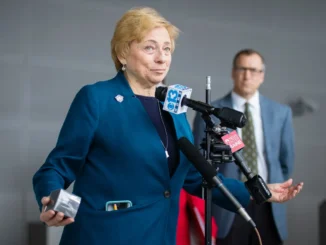
This article was originally published by the Maine Morning Star.
The International Energy Agency has estimated that offshore wind could generate $1 trillion in worldwide investments in the next 15 years.
Gov. Janet Mills said, “the time has come to bring some of that investment to Maine.”
Mills announced at a press conference Tuesday afternoon that Sears Island in Searsport is the preferred site for a designated port to support the state’s budding offshore wind industry because of its economic and environmental opportunities. The turbines will be fabricated and assembled at the dedicated port.
Within Searsport, there were two potential locations: Sears Island and Mack Point. Both are in Penobscot Bay and have garnered conflicting reactions from the public. Since Sears Island is undeveloped, proponents see it as a blank canvas ready to be transformed into an offshore wind port. But opponents argued against clearing more natural land over the redevelopment of Mack Point.
Mills laid out half a dozen reasons why she believes the 941-acre Sears Island is the best choice financially and environmentally for the people of Maine, although she emphasized that she didn’t make the decision lightly.
A map of the proposed offshore wind port on Sears Island in Searsport, Maine. (AnnMarie Hilton/ Maine Morning Star)
Since the state already owns the land, it will minimize upfront costs and eliminate the potential for leasing, making Sears Island more cost-effective in the short- and long-run, Mills said. She didn’t provide an exact number, but Mills said the entire project could ultimately cost several hundreds of millions of dollars.
The island also has the required physical characteristics, namely a large, level surface with access to deep water.
Knowing that some people may be unhappy about the decision, Mills said she has hiked the island and circumnavigated it by boat so she understands the appreciation for the island. In 2009, the state put about 600 acres — two-thirds of the island — into a permanent easement. That portion will remain untouched by the port, which will be built on about 100 acres outside of the protected area.
Searsport and the surrounding region has faced economic challenges in the past decade after a paper mill closed and took more than 500 jobs with it.
“We have not recovered from that loss,” said James Gillway, town manager of Searsport. “Offshore wind will change that.”
Representatives from Maine State Chamber of Commerce, Maine Conservation Voters and Maine Audubon were also present at the press conference in support of the announcement. Sen. Chip Curry (D-Waldo) also spoke about the opportunities this will offer by creating a new industry to “strengthen families up and down the Midcoast” with good-paying jobs.
“Offshore wind will be essential to our transition away from expensive and dirty fossil fuels, and to realize this incredible opportunity, we need port infrastructure,” said Beth Ahearn, director of government affairs for Maine Conservation Voters, who was also part of the 19-member Offshore Wind Port Advisory Group.
Organized by the Maine Department of Transportation, the advisory group met six times between 2022 and 2023 to explore prospective sites and help inform the governor’s decision.
Maine relies on natural gas to support much of its energy needs, so diversifying power sources can help stabilize prices for ratepayers, said Dan Burgess, director of the Governor’s Energy Office.
“This is an investment in Maine-made, clean energy that we think will stabilize rates,” Burgess said of offshore wind. He added, “the more we can do homegrown, the better.”
In a statement, Sean Mahoney, vice president of the Conservation Law Foundation Maine, which was also part of the advisory group, said, “Offshore wind will grow our economy and help us meet our obligations to ditch polluting fossil fuels. It’s critical that this process is now moving forward and we’re one step closer to getting this clean energy on the grid.”
In November, a coalition of organized labor and environmental groups voiced support for building a new port for offshore wind, highlighting benefits such as job-creation and the use of innovation developed by Maine people. They also stressed the urgency of moving forward with the project for environmental reasons.
The state is still waiting for the federal Bureau of Ocean Energy Management to publish a final map showing where offshore wind can be developed in the Gulf of Maine.
In the meantime, Maine DOT will begin applying for state and federal permits. That process is expected to take about a year. Construction, however, will take multiple years. Mills estimated it could wrap up in 2029.
Even before the governor’s decision, Searsport stood out among the other options.
While the water is plenty deep, there isn’t enough space in Portland, so it wasn’t a viable option, explained Kathleen Meil, senior director of policy and partnerships for Maine Conservation Voters.
Eastport, another potential location, would require going through Tribal land and has a lot of rock, granite and other materials that would need to be blasted.
“So, that leaves us with Searsport,” Meil said in an interview with Maine Morning Star last week.



